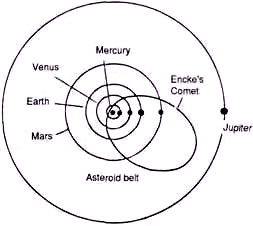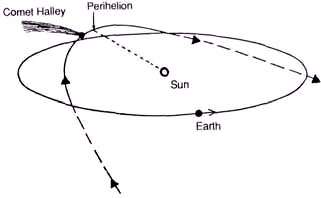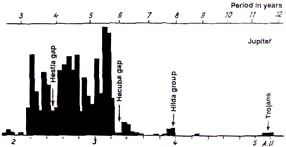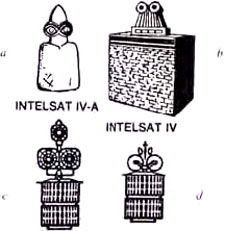|
4 - THE MESSENGERS OF GENESIS
But based on Newtonian laws, Halley concluded
that the curve described by comets is elliptical, eventually
bringing these celestial bodies back to where they had
been observed before. The “three” comets of 1531, 1607, and
1682 were unusual in that they were all orbiting in the “wrong”
direction—clockwise rather than counterclockwise; had similar
deviations from the general orbital plane of the planets around
the Sun—being inclined about 17 to 18 degrees—and were
similar in appearance.
Concluding they were one and the same comet, he plotted its course and calculated its period (the length of time between its appearances) to be about seventy-six years. He then predicted that it would reappear in 1758. He did not live long enough to see his prediction come true, but he was honored by having the comet named after him. Like that of all celestial bodies, and especially because of a comet’s small size, its orbit is easily perturbed by the gravitational pull of the planets it passes (this is especially true of Jupiter’s effect).
Each time a comet nears the Sun, its frozen material comes to life; the comet develops a head and a long tail and begins to lose some of its material as it turns to gas and vapor. All these phenomena affect the comet’s orbit; therefore, although more precise measurements have somewhat narrowed the orbital range of Halley’s comet from the seventy-four to seventy-nine years that he had calculated, the period of seventy-six years is only a practical average; the actual orbit and its period must be recalculated each time the comet makes an appearance.
Figure 20
With the aid of modern equipment, an average of five or six comets are reported each year; of them, one or two are comets on return trips, while the others are newly discovered. Most of the returning comets are short-period ones, the shortest known being that of Encke’s comet, which nears the Sun and then returns to a region slightly beyond the asteroid belt (Fig. 20) in a little over three years. Most short-period comets average an orbital period of about seven years, which carries them to the environs of Jupiter.
Typical of them is comet Giacobini-Zinner (named, like other comets, after its discoverers), which has a period of 6 ½ years; its latest passage within Earth’s view was in 1985. On the other hand there are the very-long-period comets like comet Kohoutek, which was discovered in March 1973, was fully visible in December 1973 and January 1974, and then disappeared from view, perhaps to return in 75,000 years. By comparison, the cycle of 76 years for Halley’s comet is short enough to remain in living memories, yet long enough to retain its magic as a once-in-a-lifetime celestial event.
Figure 21 When Halley’s comet appeared on its next-to-last passage around the Sun, in 1910, its course and aspects had been well mapped out in advance (Fig. 21). Still, the Great Comet of 1910, as it was then hailed, was awaited with great apprehension.
There was fear that Earth or life on it would not survive the anticipated passage because Earth would be enveloped in the comet’s tail of poisonous gases. There was also alarm at the prospect that, as was believed in earlier times, the appearance of the comet would be an ill omen of pestilence, wars, and the death of kings. As the comet reached its greatest magnitude and brilliance in May of 1910, its tail stretching over more than half the vault of heaven (Fig. 22), King Edward VII of Great Britain died. On the European continent, a series of political upheavals culminated in the outbreak of World War I in 1914.
Figure 23
The year A.D. 66 is considered by astronomers one in which Halley’s
comet made an appearance; they base their conclusion on at least two contemporary Chinese
observations. That was the year in which the Jews of Judea launched
their Great Revolt against Rome. The Jewish historian Josephus (Wars
of the Jews, Book VI) blamed the fall of Jerusalem and the
destruction of its holy Temple on the misinterpretation by the Jews
of the heavenly signs that preceded the revolt: “a star resembling a
sword which stood over the city, a comet that continued a whole
year.” Until recently the earliest certain record of the observation of a comet was found in the Chinese Chronological Tables of Shih-chi for the year 467 B.C., in which the pertinent entry reads,
Some believe a Greek inscription refers to the same comet in that year. Modern astronomers are not sure that the 467 B.C. Shih-chi entry refers to Halley’s comet; they are more confident regarding a Shih-chi entry for the year 240 B.C. (Fig. 24).
Figure 24
In April 1985, F. R. Stephenson, K. K. C. Yau, and H. Hunger reported in Nature that a reexamination of Babylonian astronomical tablets that had been lying in the basement of the British Museum since their discovery in Mesopotamia more than a century ago, shows that the tablets recorded the appearance of extraordinary celestial bodies—probably comets, they said—in the years 164 B.C. and 87 B.C.
The periodicity of seventy-seven years suggested to these scholars that the unusual celestial bodies were Halley’s comet. The year 164 B.C., as none of the scholars who have been preoccupied with Halley’s comet have realized, was of great significance in Jewish and Near Eastern history. It was the very year in which the Jews of Judea, under the leadership of the Maccabees, revolted against Greek-Syrian domination, recaptured Jerusalem, and purified the defiled Temple. The Temple rededication ceremony is celebrated to this day by Jews as the festival of Hanukkah (“Rededication”).
The 164 B.C. tablet (Fig. 25), numbered WA-41462 in the British Museum, is clearly dated to the relevant year in the reign of the Seleucid (Greek-Syrian) king Antiochus Epiphanes, the very evil King Antiochus of the Books of Maccabees. The unusual celestial object, which the three scholars believe was Halley’s comet, is reported to have been seen in the Babylonian month of Kislimu, which is the Jewish month Kislev and, indeed, the one in which Hanukkah is celebrated.
Figure 25
In The Stairway to Heaven I provided a chronology that fixed the date of the Exodus at 1433 B.C.; the Israelite entry into Canaan began forty years later, in 1393 B.C. Halley’s comet, at an interval of 76 or 77 years, would have appeared circa 1390 B.C. Did Bilam consider that event as a divine signal that the Israelite advance could not and should not be stopped? If, in biblical times, the comet we call Halley’s was considered the Scepter Star of Israel, it could explain why the Jewish revolts of 164 B.C. and A.D. 66 were timed to coincide with the comet’s appearances. It is significant that in spite of the crushing defeat of the Judean revolt by the Romans in A.D. 66, the Jews took up arms again some seventy years later in a heroic effort to free Jerusalem and rebuild the Temple.
The leader of that revolt, Shimeon Bar Kosiba, was renamed by the religious leaders Bar Kokhba, “Son of the Star,” specifically because of the above-quoted verses in Numbers 24. One can only guess whether the revolt the Romans put down after three years, in A.D. 135, was also intended as was the Maccabean one, to achieve the rededication of the Temple by the time of the return of Halley’s comet, in A.D. 142. The realization that we, in 1986, have seen and experienced the return of a majestic celestial body that had great historic impact in the past, should send a shudder down some spines, mine among them.
The planets orbit the Sun in the same direction as did the original nebula; so do their satellites, or moons; so should also the debris that either did not coalesce or that resulted from the disintegration of bodies such as comets and asteroids. Everything must keep going anticlockwise. Everything must also remain within the plane of the original disk, which is called the Ecliptic. Nibiru/Marduk did not conform to all that. Its orbit, as previously reviewed, was retrograde—in the opposite direction, clockwise. Its effect on Pluto—which according to the Sumerian texts was GA.GA and was shifted by Nibiru to its present orbit, which is not within the ecliptic but inclined 17 degrees to it—suggests that Nibiru itself followed an inclined path.
Sumerian instructions for its observation, fully discussed in The 12th Planet, indicate that relative to the ecliptic it arrived from the southeast, from under the ecliptic; formed an arc above the ecliptic; then plunged back below the ecliptic in its journey back to where it had come from.
Figure 26
Amazingly, Halley’s comet shows the same characteristics, and except for the fact that its orbit is so much smaller than that of Nibiru (currently about 76 years compared with Nibiru’s 3,600 Earth-years), an illustration of Halley’s orbit (Fig. 26) could give us a good idea of Nibiru’s inclined and retrograde path. Looking at Halley’s comet, we see a miniature Nibiru! This orbital similarity is but one of the aspects that make this comet, and others too, messengers from the past—not only the historic past, but all the way back to Genesis.
Halley’s comet is not alone in having an orbit markedly inclined to the ecliptic (a feature measured as an angle of Declination) and a retrograde direction. Nonperiodic comets—comets whose paths form not ellipses but parabolas or even hyperbolas and whose orbits are so vast and whose limits are so far away they cannot even be calculated—have marked declinations, and about half of them move in a retrograde direction. Of about 600 periodic comets (which are now given the letter “P” in front of their name) that have been classified and catalogued, about 500 have orbital periods longer than 200 years; they all have declinations more akin to that of Halley’s than to the greater declinations of the nonperiodic comets, and more than half of them course in retrograde motion.
Comets with medium orbital periods (between 200 and 20 years) and short periods (under 20 years) have a mean declination of 18 degrees, and some, like Halley’s, have retained the retrograde motion in spite of the immense gravitational effects of Jupiter. It is noteworthy that of recently discovered comets, the one designated P/Hartley-IRAS (1983v) has an orbital period of 21 years, and its orbit is both retrograde and inclined to the ecliptic.
The thinking changed again in the 1950s mainly because of two hypotheses: Fred L. Whipple (then at Harvard) suggested that comets were “dirty snowballs” of ice (mainly water ice) mixed with darker specks of sandlike material; and Jan Oort, a Dutch astronomer, proposed that longperiod comets come from a vast reservoir halfway between the Sun and the nearer stars. Because comets appear from all directions (traveling prograde, or anticlockwise; retrograde; and at different declinations), the reservoir of comets—billions of them—is not a belt or ring like the asteroid belt or the rings of Saturn but a sphere that surrounds the Solar System.
This “Oort Cloud,” as the concept came to be named, settled at a mean distance, Oort calculated, of 100,000 astronomical units (AU) from the Sun, one AU being the average distance (93 million miles) of the Earth from the Sun. Because of perturbations and intercometal collisions, some of the cometary horde may have come closer, to only 50,000 AU from the Sun (which is still ten thousand times the distance of Jupiter from the Sun). Passing stars occasionally perturb these comets and send them flying toward the Sun.
Some, under the gravitational influence of the planets, mainly Jupiter, become medium- or short-period comets; some, especially influenced by the mass of Jupiter, are forced into reversing their course (Fig. 27). This, briefly, is how the Oort Cloud concept is usually stated.
Figure 27
Studies of cometary velocities have shown, in the words of Fred L. Whipple in his book, The Mystery of Comets, that “if we are really seeing comets coming from the void, we should expect them to fly by much faster than just 0.8 kilometers per second,” which they do not. His conclusion is that,
As an alternative idea Theokas mentions that of Mark Bailey of the University of Manchester, who suggested that most comets “reside relatively close to the Sun, just beyond the orbits of the planets.” Is it perhaps, one may ask, where Nibiru/Marduk’s “distant abode” —its aphelion—is?
Oort’s new theory was called by him a “hypothesis of a common origin of comets and minor planets” (i.e., asteroids).
The comets are out there, he suggested, not because they were “born” there but because they were thrust out to there. They were fragments of larger objects, “diffused away” by the perturbations of the planets and especially by Jupiter—just as more recently the Pioneer spacecraft were made to fly off into space by the “slingshot” effects of Jupiter’s and Saturn’s gravitation.
Summing up his study, Oort put it this way:
It all begins to sound like the Enuma elish... .
Placing the origin of the comets within the asteroid belt and considering both comets and asteroids as belonging to the same “species” of celestial objects—objects of a common birth—still leaves open the questions: How were these objects created? What gave “birth” to them? What “diffused” the comets?
It is noteworthy that in the references to Oort’s work, Van Flandern picked out its true essence:
He also referred to studies, begun in 1972, by Michael W. Ovenden, a noted Canadian astronomer who introduced the concept of a “principle of least interaction action,” a corollary of which was the suggestion that,
This, Ovenden further explained in 1975 (“Bode’s Law—Truth or Consequences?” vol. 18, Vistas in Astronomy), is the only way to meet the requirement that “the cosmogonic theory must be capable of producing retrograde as well as direct” celestial motions.
He said that it was less certain that the same “breakup event” may have also given birth to the satellites of Mars and the outer satellites of Jupiter, and he estimated that the “breakup event” occurred five million years ago. He had no doubt, however, that the “breakup event” took place “in the asteroid belt.”
Physical, chemical, and dynamic properties of the resulting celestial bodies, he stated emphatically, indicate “that a large planet did disintegrate” where the asteroid belt is today. But what caused this large planet to disintegrate?
No satisfactory answer, that is, except the Sumerian one:
A key criticism of the destroyed-planet theory has been the problem of the whereabouts of the planet’s matter; when astronomers estimate the total mass of the known asteroids and comets it adds up to only a fraction of the estimated mass of the broken-up planet. This is especially true if Ovenden’s estimate of a planet with a mass ninety times that of Earth is used in the calculations.
Ovenden’s response to such criticism has been that the missing mass was probably swept up by Jupiter; his own calculations (Monthly Notes of the Royal Astronomical Society, 173, 1975) called for an increase in the mass of Jupiter by as much as 130 Earth-masses as a result of the capture of asteroids, including Jupiter’s several retrograde moons. To allow for the discrepancy between the mass (ninety times that of Earth) of the broken-up planet and the accretion of 130 Earth-sized masses to Jupiter, Ovenden cited other studies that concluded that Jupiter’s mass had decreased some time in its past.
In the absence of valid explanations for such ejections and catastrophic collisions, the only plausible theory is that offered by the Sumerian texts, which describe the orbit of Nibiru/Marduk as a vast, elliptical path that brings it periodically (every 3,600 Earth years, by my calculations) back into the asteroid belt.
Figure 28
As Figures 10 and 11 shown, the conclusion drawn from the ancient texts was that Nibiru/Marduk passed by Tiamat on her outer, or Jupiter, side; repeated returns to that celestial zone can account for the size of the “gap” there. It is the periodic return of Nibiru/Marduk that causes the “ejecting” and “sweeping.”
Indeed, spectrographic studies of asteroids reveal that some of them “were heated within the first few hundred million years after the origin of the solar system” by heat so intense as to melt them; “iron sank to their centers, forming strong stony-iron cores, while basaltic lavas floated to their surface, producing minor planets like Vesta” (McGraw-Hill Encyclopedia of Astronomy). The suggested time of the catastrophe is the very time indicated in The 12th Planet—some 500 million years after the formation of the Solar System.
Part of the puzzle was already answered when we showed that the ancient notion of the asteroid belt as a divider of the waters “above” and the water “below” is corroborated by modern science. But there was more to this preoccupation with water. Tiamat was described as a “watery monster,” and the Mesopotamian texts speak of the handling of her waters by Nibiru/Marduk:
The concept of an asteroid belt not only as a divider between the waters of the planets above and below it but also as a “guardian” of Tiamat’s own waters is echoed in the biblical verses of Genesis, where the explanation is given that the “Hammered-out bracelet” was also called Shama’im, the place “where the waters were.” References to the waters where the Celestial Battle and the creation of the Earth and the Shama’im took place are frequent in the Old Testament, indicating millennia-old familiarity with Sumerian cosmogony even at the time of the Prophets and Judean kings.
An example is found in Psalm 104, which depicts the Creator as,
These verses are almost a word-for-word copy of the verses in Enuma elish; in both instances, the placing of the asteroid belt “where the waters were” followed the earlier acts of the splitting up of Tiamat and having the invader’s “wind” thrust the half that became Earth into a new orbit. The waters of Earth would explain the whereabouts of some or most of Tiamat’s waters. But what about the remains of her other part and of her satellites? If the asteroids and comets are those remains, should they not also contain water?
But the presence of water molecules in the surface materials indicates that the minerals that make up the asteroid have captured water and combined with it. Direct confirmation of this finding was observed in August 1982, when a small asteroid that came too close to Earth plunged into the Earth’s atmosphere and disintegrated; it was seen as “a rainbow with a long tail going across the sky.” A rainbow appears when sunlight falls on a collection of water drops, such as rain, fog, or spray.
He pointed out that carbonaceous meteorites also “show signs of having been extensively affected by water in times past.” The celestial body designated 2060 Chiron, interesting in many ways, also confirms the presence of water in the remnants of the Celestial Battle. When Charles Kowal of the Hale Observatories on Mount Palomar, California, discovered it in November 1977, he was not certain what it was.
He simply referred to it as a planetoid, named it temporarily “O-K” for “Object Kowal,” and opined that it might be a wayward satellite of either Saturn or Uranus. Several weeks of follow-up studies revealed an orbit much more elliptical than that of planets or planetoids, one closer to that of comets. By 1981 the object was determined to be an asteroid, perhaps one of others to be found reaching as far out as Uranus, Neptune or beyond, and was given the designation 2060 Chiron.
However, by 1989, further observations by astronomers at Kitt Peak National Observatory (Arizona) detected an extended atmosphere of carbon dioxide and dust around Chiron, suggesting that it is more cometlike. The latest observations have also established that Chiron “is essentially a dirty snowball composed of water, dust and carbon-dioxide ice.”
And all scientists concurred with the evaluation by astrophysicists at the Max Planck Institute for Physics and Astrophysics in Munich that was seen were “the oldest and essentially unchanged specimens of the material from the birth of the Solar System.”
Figure 29
Figure 30
As intensive observations began when Halley’s comet developed its coma and tail in November 1985, astronomers at the Kitt Peak Observatory tracking the comet with telescopes reported it was certain,
A statement by Susan Wyckoff of Arizona State University claimed that "this was the first strong evidence that water ice was prevalent.”
The spacecraft’s spectrometer, which “sees” the atoms of its subject, revealed that “the comet was losing 12 tons of water per second.” As it neared perihelion on March 6, 1986, Ian Stewart, the director of NASA’s Halley’s project at the Ames Research Center, reported that the rate of water loss “increased enormously,” first to 30 tons a second and then to 70 tons a second; he assured the press, however, that even at this rate Halley’s comet had “enough water ice to last thousands of more orbits.” The close encounters with Halley’s comet began on March 6, 1986, when Vega 1 plunged through Halley’s radiant atmosphere and, from a distance of less than 6,000 miles, sent the first-ever pictures of its icy core.
The press dutifully noted that what Mankind was seeing was the nucleus of a celestial body that had evolved when the Solar System began. On March 9, Vega 2 flew within 5,200 miles of Halley’s nucleus and confirmed the findings of Vega 1. The spacecraft also revealed that the comet’s “dust” contained chunks of solid matter, some boulder size, and that this heavier crust or layer enveloped a nucleus where the temperature—almost 90 million miles from the Sun—was a hot 85 degrees Fahrenheit.
The shape of the nucleus was rough and irregular (Fig. 31), some describing it as “two peas in a pod” and some as an irregularly shaped “potato.” From the nucleus five main jets were emitting streams of dust and 80 percent water vapor, indicating that within the carbonaceous crust the comet contained “melted ice”—liquid water. Figure 31
These preliminary conclusions were reaffirmed in October 1986, at an international conference in Heidelberg, West Germany. And in December 1986, scientists at the John Hopkins University announced that evaluation of data collected in March 1986 by the small Earth orbiting satellite IUE (International Ultraviolet Explorer) revealed an explosion on Hailey’s Comet that blew 100 cubic feet of ice out of the comet’s nucleus.
In the discoveries concerning the comets and the asteroids, something else came to life: the ancient knowledge of Sumer.
CELESTIAL “SEEING EYES”
|












